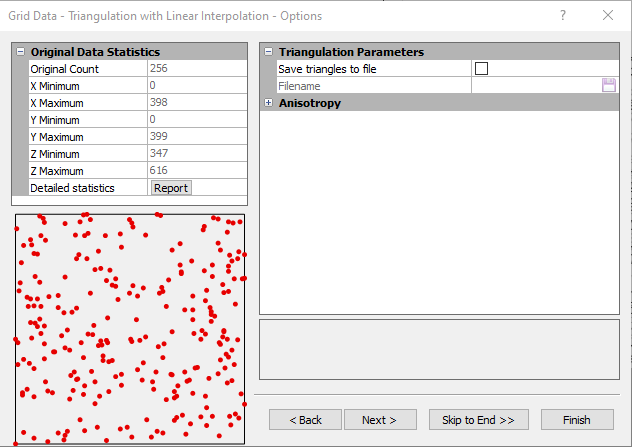Triangulation with Linear Interpolation
The Triangulation with Linear Interpolation method in Surfer uses the optimal Delaunay triangulation. The algorithm creates triangles by drawing lines between data points. The original points are connected in such a way that no triangle edges are intersected by other triangles. The result is a patchwork of triangular faces over the extent of the grid. This method is an exact interpolator.
Each triangle defines a plane over the grid nodes lying within the triangle, with the tilt and elevation of the triangle determined by the three original data points defining the triangle. All grid nodes within a given triangle are defined by the triangular surface. Because the original data are used to define the triangles, the data are honored very closely.
Triangulation with Linear Interpolation works best when your data are evenly distributed over the grid area. Data sets that contain sparse areas result in distinct triangular facets on the map.
Triangulation with Linear Interpolation Options Dialog
In the Grid Data dialog, specify Triangulation with Linear Interpolation as the Gridding Method and click the Next button to open the Grid Data Triangulation with Linear Interpolation Options dialog.
|
|
|
Set the anisotropy options and save Delaunay triangles in the Grid Data Triangulation with Linear Interpolation Options dialog. |
Save Triangles
Check the Save Triangles To box to export the Delaunay triangles to a file. The resulting file can be loaded as a base map and combined with other maps (i.e. contour maps, 3D surface maps, etc.).
Click the ![]() button to open the Export Triangles dialog. Specify a Save In location, File name, and Save as type. The Delaunay triangle export formats include: .BLN, .BNA, .EMF, .GSB, .MIF, .PDF (Vector), and .WMF. Click the Save button to return to the Grid Data Triangulation with Linear Interpolation Options dialog.
button to open the Export Triangles dialog. Specify a Save In location, File name, and Save as type. The Delaunay triangle export formats include: .BLN, .BNA, .EMF, .GSB, .MIF, .PDF (Vector), and .WMF. Click the Save button to return to the Grid Data Triangulation with Linear Interpolation Options dialog.
Anisotropy
For more information about anisotropy options see Anisotropy.
References
The Surfer implementation of Triangulation with Linear Interpolation is based upon three papers. Lee and Schachter (1980) present a complete discussion of (Delaunay) triangulation, including the details of two algorithms and the underlying mathematical proofs. Lawson (1977) is equally informative. The algorithm presented in Guibas and Stolfi (1985) form the basis for the Surfer implementation.
Guibas, L., and J. Stolfi (1985), 'Primitives for the Manipulation of General Subdivisions and the Computation of Voronoi Diagrams', ACM Transactions on Graphics, v. 4, n. 2, p. 74-123.
Lawson, C. L. (1977), 'Software for C1 surface interpolation', Mathematical Software III, J. Rice ( ed.), Academic Press, New York, p. 161-193.
Lee, D. T., and Schachter, B. J. (1980), 'Two Algorithms for Constructing a Delaunay Triangulation', International Journal of Computer and Information Sciences, v. 9, n. 3, p. 219-242.
